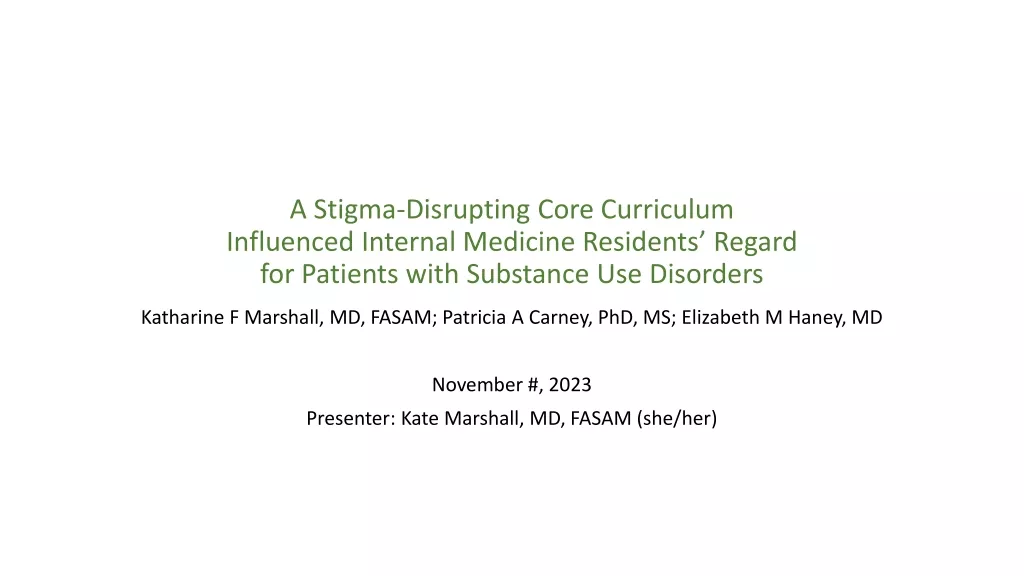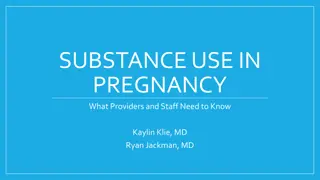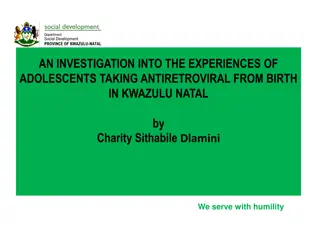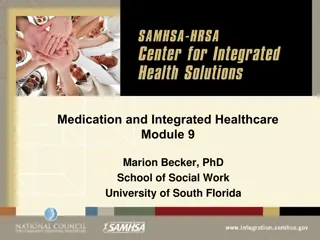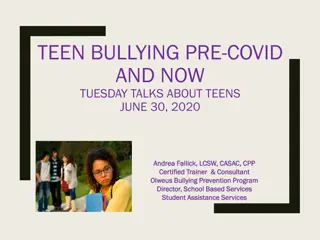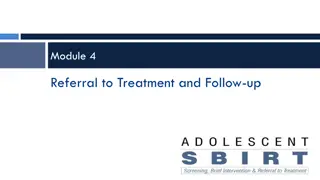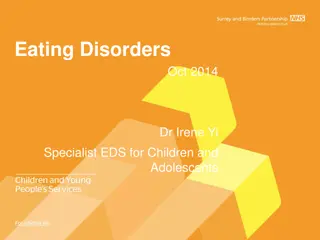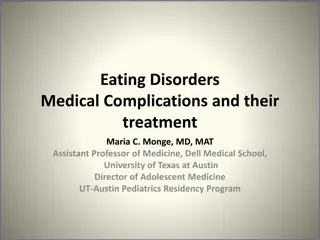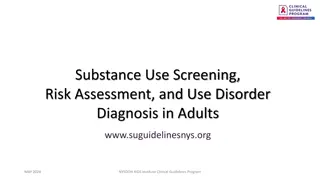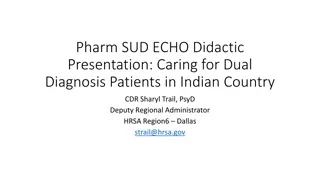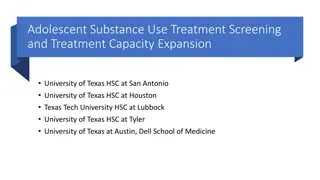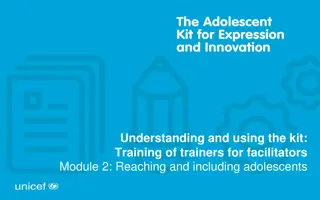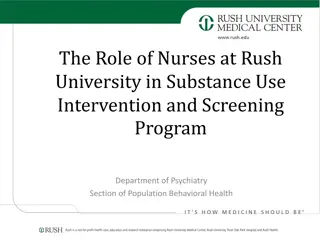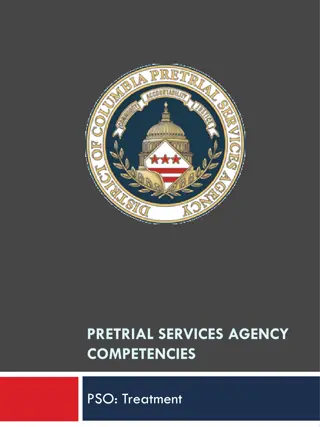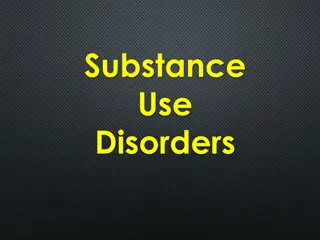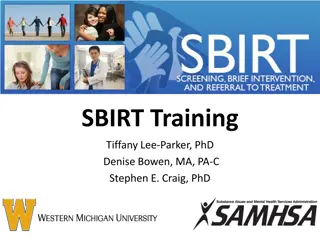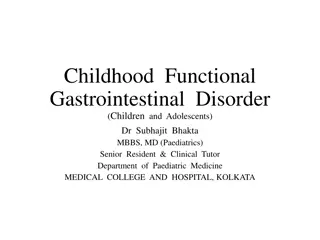Specialized Substance Use Disorders Treatment for Adolescents and Emerging Adults
The best adolescent treatment programs, unique needs of emerging adults, and addressing disparities among adolescents and emerging adults of color. Learn about evidence-based practices and pathways of adolescent recovery for effective treatment.
Download Presentation

Please find below an Image/Link to download the presentation.
The content on the website is provided AS IS for your information and personal use only. It may not be sold, licensed, or shared on other websites without obtaining consent from the author.If you encounter any issues during the download, it is possible that the publisher has removed the file from their server.
You are allowed to download the files provided on this website for personal or commercial use, subject to the condition that they are used lawfully. All files are the property of their respective owners.
The content on the website is provided AS IS for your information and personal use only. It may not be sold, licensed, or shared on other websites without obtaining consent from the author.
E N D
Presentation Transcript
ICB Presents Specialized Substance Use Disorders Treatment for Adolescents and Emerging Adults Presenter Mark Sanders LCSW, CADC
Outline The best adolescent programs The unique treatment needs of emerging adults Addressing disparity adolescents and emerging adults of color Adolescent and emerging adult friendly evidence-based practices 2
The Best Adolescent Treatment Programs (Ages 12 17) Have a licensed and certified staff ( Book Wise and Street Wise ) High staff morale Low staff turnover A good staff to client ratio and multidisciplinary team, staff diversity, gender competence 3
The Best Adolescent Treatment Programs Continued Believe in the least restrictive alternative Address co-occurring conditions Depression Trauma ADD Eating Disorders Self-harming behavior The Price of Privilege Process Addictions Educational component 4
The Best Adolescent Treatment Programs Continued Hire staff who remember their own adolescence Hire staff who enjoy working with adolescents Hire staff who recognize that each generation of adolescents experience greater isolation 5
The Best Adolescent Treatment Programs Continued Stresses the importance of adolescent voice and choice Recognizes the importance of the peer group Lots of activities Honors multiple pathways and styles of recovery 6
Pathways of Adolescent Recovery Treatment assisted Total abstinence Peer assisted (Adolescent Friendly Mutual Aid Groups) Use of technology 7
Pathways of Adolescent Recovery Continued Partial recovery One drug at a time Drug use vacations (Build recovery Capital: social, recreational, educational, vocational, occupational, emotional, relational, prosocial recovery support) Faith-based recovery 8
Pathways of Adolescent Recovery Continued Medication assisted Harm reduction Recovery high schools Dual recovery 9
The Best Adolescent Treatment Programs Continued Have a strong family component Treatment team outreach If we wait for the family to hit rock bottom, they can outwait us William White, MA Address triangles 10
The Best Adolescent Treatment Programs Continued Have a strong family component Parenting Styles Autocratic Democratic Laissez-faire 11
The Best Adolescent Treatment Programs Continued Have a strong family component Explain the recovery process Explain how to support adolescent recovery Harm reduction Encourage the family to take care of themselves 12
The Best Adolescent Treatment Programs Continued Strong continuous care component Long-term monitoring Strong alumni component Recognize that an improvement in global functioning usually occurs prior to abstinence 13
Emerging Adults With Substance Use Disorders Age 18-25 Not adolescents! Most do not feel completely adult The highest overdose rates, poorest outcomes, premature terminations, most binge drinking, heaviest alcohol use, highest opioid and marijuana use, highest poly-substance use
The Work of Jeffery Arnett Article published in the Journal of American Psychologist (2000) 5 Features of Emerging Adulthood The age of optimism Feeling in-between Identity exploration Self-focus Instability 16
Other Features of Emerging Adulthood Time of experimentation Time of personal freedom Time of feeling stressed out Time of high pressure Source: Douglas Smith, 2018 17
Other Features of Emerging Adulthood Continued Time of independence Time of unpredictability Time of many worries Time of planning for the future Source: Douglas Smith, 2018 18
Other Features of Emerging Adulthood Continued Time of separating from parents Time of learning to think for yourself Time of feeling adult in some ways and not in other ways Time of gradually becoming an adult Source: Douglas Smith, 2018 19
Discussion What are some reasons emerging adults are vulnerable to substance use disorders?
Substance Use Disorders Vulnerability for Emerging Adults Cultural norm of heavy drinking and substance use Peer influence Family history Trauma
Substance Use Disorders Vulnerability for Emerging Adults Continued Self-medication College attendance First psychotic episodes and other signs of mental illness Depression Pressure to be perfect
Tailoring Treatment for Emerging Adults Support around completion of developmental tasks A community of peers other emerging adults Family therapy different than with adolescents Medication assisted recovery Harm reduction Addressing the stress of emerging adulthood Addressing co-occurring conditions 23
Tailoring Treatment for Emerging Adults Continued On college campuses Young people in recovery Recovery dorms Recovery housing Recovery sororities and fraternities Recovery service Trips 24
Discussion What challenges do counselors who are emerging adults face when counseling emerging adults? As a counselor, how do you address the challenges? What challenges do counselors who are not emerging adults face when counseling emerging adults? As a counselor, how would you address the challenges? 25
Jeffery Arnett Emerging adulthood is the age of optimism. By achieving the developmental tasks of emerging adulthood, EA s emerge as successful adults. 27
Challenges Faced by Emerging Adults of Color Racism Discrimination Felony arrests Education lower high school graduation rates and college education Dehumanization + Ignored Losses = Rage which increases the risk of substance use disorders
Challenges Faced by Emerging Adults of Color Continued Fear of being dead soon Premature entry into adulthood Treatment disparities
Disparities Access to treatment Often having to leave the community to access treatment Less likely to work with clinicians of their culture Evidence based practices not developed with emerging adults of color in mind 30
Addressing Disparities Advocacy to address disparities Invest in increasing clinicians of color Create a welcoming environment for a diversity of clients Increase training on counseling emerging adults of color Engage emerging adults of color in discussions on how oppression contributes to substance use Address dehumanization and ignored losses Integrate culture and evidence-based practices 31
Evidence-based Practices Friendly to the Developmental Needs of Adolescents and Emerging Adults Motivational Interviewing Feedback Informed Treatment CBT The use of Motivational Incentives Medication Assisted Treatment Meditation and Mindfulness


